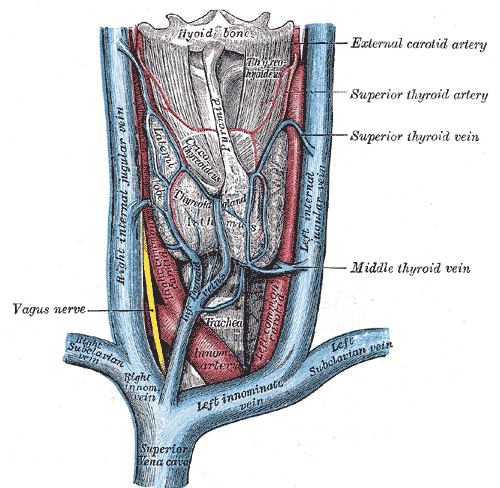[1]
Drouin L, Pistorius MA, Lafforgue A, N'Gohou C, Richard A, Connault J, Espitia O. [Upper-extremity venous thrombosis: A retrospective study about 160 cases]. La Revue de medecine interne. 2019 Jan:40(1):9-15. doi: 10.1016/j.revmed.2018.07.012. Epub 2018 Aug 16
[PubMed PMID: 30122260]
Level 2 (mid-level) evidence
[2]
Zimmerman S, Davis M. Rapid Fire: Superior Vena Cava Syndrome. Emergency medicine clinics of North America. 2018 Aug:36(3):577-584. doi: 10.1016/j.emc.2018.04.011. Epub 2018 Jun 12
[PubMed PMID: 30037444]
[3]
Carmo J, Santos A. Chronic Occlusion of the Superior Vena Cava. The New England journal of medicine. 2018 Jul 5:379(1):e2. doi: 10.1056/NEJMicm1711273. Epub
[PubMed PMID: 29972752]
[4]
De Potter B,Huyskens J,Hiddinga B,Spinhoven M,Janssens A,van Meerbeeck JP,Parizel PM,Snoeckx A, Imaging of urgencies and emergencies in the lung cancer patient. Insights into imaging. 2018 Aug
[PubMed PMID: 29644546]
[5]
Friedman T, Quencer KB, Kishore SA, Winokur RS, Madoff DC. Malignant Venous Obstruction: Superior Vena Cava Syndrome and Beyond. Seminars in interventional radiology. 2017 Dec:34(4):398-408. doi: 10.1055/s-0037-1608863. Epub 2017 Dec 14
[PubMed PMID: 29249864]
[6]
Kalinin RE, Suchkov IA, Shitov II, Mzhavanadze ND, Povarov VO. [Venous thromboembolic complications in patients with cardiovascular implantable electronic devices]. Angiologiia i sosudistaia khirurgiia = Angiology and vascular surgery. 2017:23(4):69-74
[PubMed PMID: 29240058]
[7]
Ghorbani H, Vakili Sadeghi M, Hejazian T, Sharbatdaran M. Superior vena cava syndrome as a paraneoplastic manifestation of soft tissue sarcoma. Hematology, transfusion and cell therapy. 2018 Jan-Mar:40(1):75-78. doi: 10.1016/j.htct.2017.09.001. Epub 2018 Feb 17
[PubMed PMID: 30057975]
[8]
Labriola L, Seront B, Crott R, Borceux P, Hammer F, Jadoul M. Superior vena cava stenosis in haemodialysis patients with a tunnelled cuffed catheter: prevalence and risk factors. Nephrology, dialysis, transplantation : official publication of the European Dialysis and Transplant Association - European Renal Association. 2018 Dec 1:33(12):2227-2233. doi: 10.1093/ndt/gfy150. Epub
[PubMed PMID: 29893920]
[9]
Mansour A, Saadeh SS, Abdel-Razeq N, Khozouz O, Abunasser M, Taqash A. Clinical Course and Complications of Catheter and Non-Catheter-Related Upper Extremity Deep Vein Thrombosis in Patients with Cancer. Clinical and applied thrombosis/hemostasis : official journal of the International Academy of Clinical and Applied Thrombosis/Hemostasis. 2018 Nov:24(8):1234-1240. doi: 10.1177/1076029618788177. Epub 2018 Jul 19
[PubMed PMID: 30025472]
[10]
Khan UA, Shanholtz CB, McCurdy MT. Oncologic Mechanical Emergencies. Hematology/oncology clinics of North America. 2017 Dec:31(6):927-940. doi: 10.1016/j.hoc.2017.08.001. Epub
[PubMed PMID: 29078930]
[11]
Nossair F, Schoettler P, Starr J, Chan AKC, Kirov I, Paes B, Mahajerin A. Pediatric superior vena cava syndrome: An evidence-based systematic review of the literature. Pediatric blood & cancer. 2018 Sep:65(9):e27225. doi: 10.1002/pbc.27225. Epub 2018 May 21
[PubMed PMID: 29781569]
Level 1 (high-level) evidence
[12]
Ierardi AM, Jannone ML, Petrillo M, Brambillasca PM, Fumarola EM, Angileri SA, Crippa M, Carrafiello G. Treatment of venous stenosis in oncologic patients. Future oncology (London, England). 2018 Dec:14(28):2933-2943. doi: 10.2217/fon-2017-0737. Epub 2018 Apr 6
[PubMed PMID: 29623736]
[13]
Kalra M, Sen I, Gloviczki P. Endovenous and Operative Treatment of Superior Vena Cava Syndrome. The Surgical clinics of North America. 2018 Apr:98(2):321-335. doi: 10.1016/j.suc.2017.11.013. Epub
[PubMed PMID: 29502774]
[14]
Hague J, Tippett R. Endovascular techniques in palliative care. Clinical oncology (Royal College of Radiologists (Great Britain)). 2010 Nov:22(9):771-80. doi: 10.1016/j.clon.2010.08.002. Epub 2010 Sep 15
[PubMed PMID: 20833516]
[15]
Gradishar WJ, Magid D, Bitran JD. Supportive care of the lung cancer patients. Hematology/oncology clinics of North America. 1990 Dec:4(6):1183-99
[PubMed PMID: 1704881]
[16]
Lianos GD, Hasemaki N, Tzima E, Vangelis G, Tselios A, Mpailis I, Lekkas E. Superior vena cava syndrome due to central port catheter thrombosis: a real life-threatening condition. Il Giornale di chirurgia. 2018 Mar-Apr:39(2):101-106
[PubMed PMID: 29694310]
[17]
Kuo TT, Chen PL, Shih CC, Chen IM. Endovascular stenting for end-stage lung cancer patients with superior vena cava syndrome post first-line treatments - A single-center experience and literature review. Journal of the Chinese Medical Association : JCMA. 2017 Aug:80(8):482-486. doi: 10.1016/j.jcma.2017.04.005. Epub 2017 May 10
[PubMed PMID: 28501315]
[18]
Nakano T, Endo S, Kanai Y, Otani S, Tsubochi H, Yamamoto S, Tetsuka K. Surgical outcomes after superior vena cava reconstruction with expanded polytetrafluoroethylene grafts. Annals of thoracic and cardiovascular surgery : official journal of the Association of Thoracic and Cardiovascular Surgeons of Asia. 2014:20(4):310-5
[PubMed PMID: 23801179]

